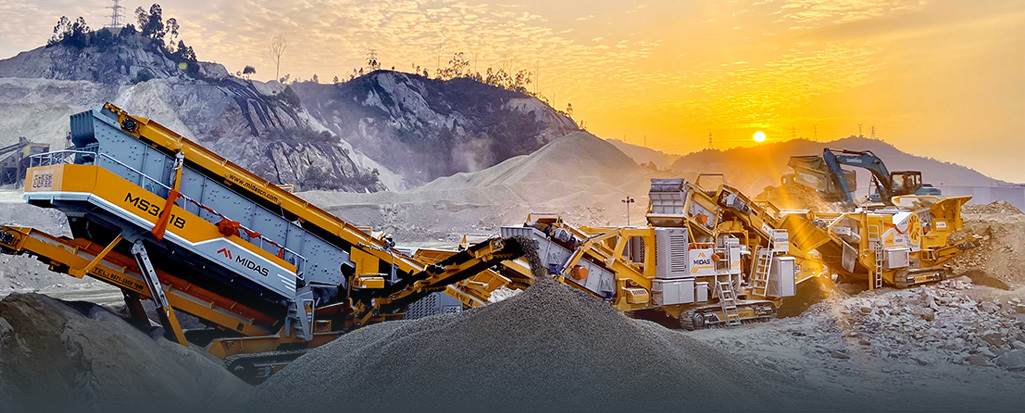The gap in the sand and gravel industry is as high as 80%.
【Summary Description 】Under the impact of the epidemic, since various places have resumed work after the Spring Festival, many provinces have released their project investment plans for 2020. As of March 20, 25 provinces and cities including Beijing, Hebei, Shanghai, Guangdong, Sichuan, Ningxia, etc.
01. Under the big infrastructure, sand and gravel meet opportunities again!
Against the impact of the epidemic, since various places have resumed work after the Spring Festival, many provinces have released their 2020 project investment plans. As of March 20, 25 provinces, cities and districts including Beijing, Hebei, Shanghai, Guangdong, Sichuan, and Ningxia have released 22,000 projects with a total investment of 49.6 trillion yuan, of which the total planned investment in 2020 is 7.6 trillion yuan. All signs are increasingly clear that big infrastructure is becoming a new driving force for the economy.
Speed up progress, speed up approval, and speed up construction. Under the pressure of stabilizing growth, the approval speed of infrastructure projects has also increased recently.
Data released by the National Development and Reform Commission show that as of March 20, the infrastructure projects approved by the National Development and Reform Commission reached 228.605 billion yuan, 93.029 billion yuan more than the same period last year; as of February 25, the resumption rate of 533 major transportation projects nationwide was 70.17%.
02. Who would have thought that there would be a "famine" of sand?
At the same time, the current resource and environmental constraints and control are increasingly strengthened, the mining of natural river sand is banned and restricted, and the global sand shortage is getting worse, causing the contradiction between the supply and demand of construction sand and gravel to become more and more prominent.
Since 2018, the supply of sand and gravel aggregates in many parts of the country has been in urgent need, and "sand is hard to find" is almost normal. Data shows that the annual demand for construction sand in Henan is about 210 million tons, while the approved river sand mining volume in the province is only about 40 million tons, with a gap of more than 80%; the average annual construction sand volume in Fujian from 2019 to 2021 is predicted to be 110 million cubic meters, but the gap is 75%.
In Hubei, due to the risk of supply interruption of raw materials for making concrete, some high-speed rail, airport, highway and other projects were forced to stop work, and the construction units complained about this. In addition, Hunan, Jiangxi, Zhejiang, Shaanxi, Hainan and other provinces have also experienced "sand shortages" one after another. Some sand fields in Huizhou, Guangdong Province have even adopted a "lottery supply" to supply sand and gravel in limited quantities every day.
In fact, in the past, the sand and gravel aggregates used in my country were basically natural sand and gravel collected directly from rivers and mines. Years of mining have put the resources at risk of depletion. With the continuous advancement of my country's ecological civilization construction, resource and environmental constraints and control have become increasingly strengthened, making the contradiction between supply and demand more prominent, and the price of sand and gravel has continued to rise. In some areas, the price of sand and gravel has increased by nearly 100%. As a last resort, coastal areas such as Guangdong, Fujian, Zhejiang, Jiangsu, and Hainan have begun to import large quantities of sand and gravel from countries such as Malaysia and North Korea.
Under the crisis of resource supply, where is the road for the sand and gravel industry?
03. Artificial sand becomes the "new favorite" of the market
1. Resource advantage: various waste resources can be used, such as tailings, construction waste, pebbles, stone chips, etc., which not only solves the problem of environmental pollution, but also meets the requirements of energy conservation and environmental protection;
2. Quality advantage: clean raw materials, continuous grading of aggregates, and the fineness modulus of artificial sand can be adjusted according to the formula of concrete and mortar to meet the needs of various types of dry-mixed mortar, commercial concrete, asphalt concrete, high-performance concrete, etc.;
3. Management advantage: There is a stable legal entity, mining license, and fixed business premises. It can effectively prevent illegal mining, protect the environment, increase government tax revenue and improve the comprehensive utilization rate of resources;
4. Cost advantage: The preparation of concrete can save 10%-30% of cement; it can be matched with dry mixing without drying, saving 10 yuan/ton of drying cost.
Artificial sand is widely used in my country. It is understood that the earliest application of domestic machine-made sand and gravel was in some major projects in Beijing in the early days of the founding of New China, and in the construction of the Maotiao River cascade hydropower station in central Guizhou in 1958. In recent years, high-quality machine-made sand has also been used in the construction of major projects including the Hong Kong-Zhuhai-Macao Bridge and the Three Gorges Dam.
"High-quality machine-made sand and gravel are industrial products manufactured on a large scale using modern crushing and screening equipment, and their performance is better than that of natural sand and gravel." Hu Youyi believes that natural sand and gravel have been washed on the river for tens of thousands of years, and their surface and morphology are different from machine-made sand and gravel. However, with the continuous advancement of machine-made sand and gravel processing technology and the continuous improvement of equipment technology, machine-made sand and gravel can be made better than natural sand and gravel.
It is generally believed in the industry that industrially produced products are better than natural products in terms of quality balance and other aspects, so machine-made sand and gravel can completely replace natural sand and gravel, and even have more advantages in the application of high-performance concrete.
On November 4, 2019, the Ministry of Industry and Information Technology, the National Development and Reform Commission, the Ministry of Natural Resources, the Ministry of Ecology and Environment and other ten departments jointly issued the "Several Opinions on Promoting the High-quality Development of the Mechanism Sand and Gravel Industry", emphasizing the reasonable allocation of sand and gravel mining rights, standardizing sand and gravel resource management, encouraging the use of waste rock, tailings, etc. to produce mechanism sand and gravel, and saving natural resources.
The above-mentioned "Opinions" require a coordinated layout to establish a reasonable domestic mechanism sand and gravel supply system. According to the important urban agglomerations such as Beijing-Tianjin-Hebei and its surrounding areas, the Yangtze River Delta, the Pearl River Delta, and the construction needs of the central and western regions, the mining rights of sand and gravel resources should be reasonably allocated. Expand the sources of sand and gravel, standardize the management of sand and gravel resources, encourage the use of waste rock and tailings from iron, molybdenum, vanadium and titanium mines to produce mechanism sand and gravel, save natural resources, and promote industrial agglomeration.
The "Opinions" emphasizes the need to strengthen the development and integration of sand and gravel resources, promote the scale and intensive production of mechanism sand and gravel, and build a number of large-scale production bases. Encourage the development of industrial parks integrating sand and gravel, cement, concrete, and prefabricated buildings to give play to the agglomeration effect. We will strive to form a relatively complete and reasonable mechanism sand and gravel supply guarantee system by 2025, with a significant increase in the proportion of high-quality mechanism sand and gravel, and the production capacity of super-large mechanism sand and gravel enterprises with an annual output of 10 million tons or more will reach 40%, and the proportion of mechanism sand and gravel produced by tailings, waste stone, etc. will increase significantly.
The industry believes that this guideline on the development of the sand and gravel industry in China plays a pivotal role and important significance in promoting the transformation and upgrading of the industry, technological progress and high-quality development, and will promote China's sand and gravel industry into a new era of high-quality development.
Common mechanism sand raw materials
① Construction waste: Crushed stone, concrete blocks and brick and tile fragments in construction waste can be used as sand and gravel aggregates. Using them as raw materials to produce mechanism sand can greatly reduce the cost of raw material input.
② River pebbles: Pure natural stone, with good color, no fading, non-toxic, hard texture and other characteristics, is a green sand making raw material. The mechanism sand made of river pebbles has certain advantages instead of natural sand.
③ Quartz sandstone: a kind of stone material, containing more than 90% quartz content, with good effect in grain shape and strength, and is one of the more common raw materials for producing machine-made sand on the market.
④ Sandstone: sedimentary rock, mainly composed of feldspar and quartz, with stable structure and sand content of more than 50%. It is a common raw material for machine-made sand production. There is a high content of stone powder in the raw material crushing process. Therefore, when making sand, it is necessary to select sand making equipment with dust removal performance.
⑤ Slag: industrial waste, with a wide source, low cost in the actual sand making process, and is also a common raw material for sand making.
04. These problems need to be solved urgently
"While leading by science and technology, cross-border integration, and promoting the high-quality and green development of the sand and gravel industry, we should also face up to problems and shortcomings." Hu Youyi, president of the China Sand and Gravel Association, said bluntly, "The development of the sand and gravel aggregate industry does face some problems and contradictions that need to be solved urgently."
First of all, the management of the sand and gravel industry involves multiple departments, and coordination and supervision are difficult. The mining, production and application of sand and gravel involve multiple departments such as natural resources, agriculture, forestry, water conservancy, maritime affairs, urban and rural construction, etc. The sand and gravel industry has always had the problem of repeated cross-management by multiple departments. It is urgent to establish a coordination mechanism among local governments, industry associations and enterprises and formulate industry access standards.
Secondly, unlicensed mining and indiscriminate mining are rampant. Driven by interests, some regions still have unlicensed mining, indiscriminate mining, unfair and unjust competition phenomena and problems. The vicious competition of low-priced and inferior sand and gravel disrupts the market and affects the use and development of high-quality machine-made sand and gravel.
Thirdly, the efforts in scientific and technological research and development, standardization construction and quality inspection are not enough. The survey shows that the current investment in the research and development of machine-made sand and gravel technology in my country is not enough, resulting in a relatively backward overall level, and there are no special sand and gravel research and development and design institutions, and there are no sand and gravel majors in colleges and universities. The national and enterprise testing institutions and related mechanisms need to be improved.
In this regard, the industry generally believes that streamlining management functions, strictly managing the industry, improving supporting policies, encouraging scientific and technological research and development, improving the quality control system, and improving standards and specifications are the only way to resolve contradictions and problems and promote the healthy and sustainable development of the mechanism sand and gravel industry.
At the same time, according to the development trend of the mechanism sand and gravel industry, it is necessary to formulate and issue relevant industrial policies such as the access conditions of the mechanism sand and gravel industry in a timely manner, and strengthen the access requirements in terms of planning layout, process equipment, production scale, product quality, energy consumption, clean production, environmental protection, comprehensive utilization and production. Increase supervision and inspection efforts, and resolutely ban illegal activities such as unlicensed mining and indiscriminate mining. Each region can establish a filing system for sand and gravel supply enterprises to prohibit illegal sand and gravel products from entering the market.
In addition, it is also necessary to combine regional resource distribution, market demand, quality and transportation and logistics conditions, and plan and layout green and environmentally friendly mechanism sand and gravel production bases around the market. When planning the layout of the mechanism sand and gravel production base, scientific planning should be carried out from mining to post-mining governance in the mining area, and enterprises should be strictly required to mine and govern in accordance with the planning requirements, so that the mining area can meet the requirements of restoration and governance or secondary development after mining.












